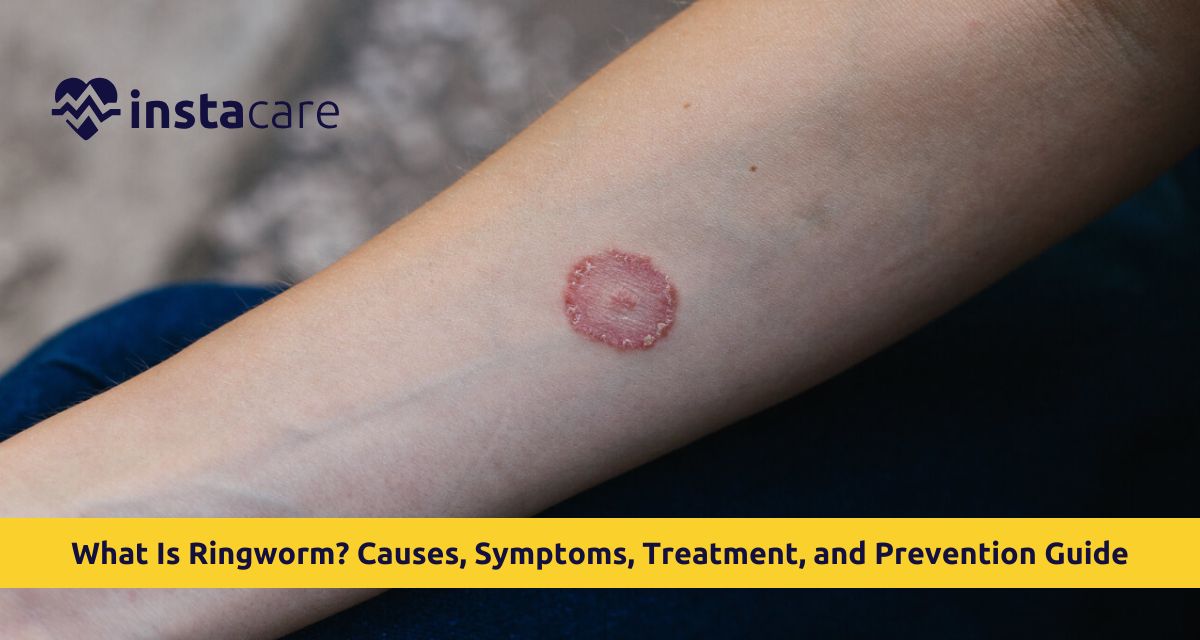Ringworm on skin is a skin disease that infects millions of people worldwide. It's surprising that ringworm has no worm origin but a fungal origin. Ringworm is an infectious disease producing itching ring-shaped blisters and appearing on the scalp, skin, foot, or nails. In order to prevent and treat ringworm, an individual should know what ringworm is.
Ringworm in humans is also infectious by usual contact with contaminated skin, dirty surfaces, or even household pets. While not usually fatal, it is highly irritating and causes cosmetic problems if not treated. Control is achieved through early diagnosis, correct medication, and prevention.
What Is Ringworm?
Ringworm is infection of the skin by a ringworm group of fungus called dermatophytes. They infect keratin, skin, hair, and nail protein. Medical term of infection is tinea and its nomenclature is based on the site of infection:
- Tinea corporis — Body ringworm
- Tinea capitis — ringworm on scalp
- Tinea pedis — Athlete's foot (feet)
- Tinea cruris — Jock itch (groin)
- Tinea unguium — Nail fungus
One of the most frequent symptoms of ringworm is scaly ring-colored red rash typically with a visible center. Because of its extreme contagiousness, knowing what it is highly important in how to prevent ringworm and in healing.
Causes of Ringworm
causes of ringworm are straight by dermatophyte fungal infection. Dermatophytes thrive in warmth and dampness and are transmittable through:
- Direct body contact with an infected person.
- Contact with infected animals, primarily dogs and cats.
- Contact with infested objects such as towels, combs, hats, or gym equipment.
- Walking barefoot on public places, especially showers or swimming pools.
- Compromised immune systems that leave the body susceptible to infection.
- Over-sweating and inadequate personal hygiene, the perfect paradise for fungi to develop.
Ringworm is not an age-related issue, but children, athletes, and those whose immunity is compromised are most susceptible.
Symptoms of Ringworm
Ringworm, based on where it is located, has the following signs that usually consist of:
- Red, circular rashes with elevated border and paler color in the middle.
- Burning or itching, often at the site.
- Scaling, cracking, or peeling of the skin, particularly where it is moist, such as feet or groin.
- Patchy baldness or hair loss, particularly if ringworm infects the scalp.
- Thick, yellow, or brittle nails in the event of nail fungus.
The rash is spread with time if it is not treated and infection or secondary bacterial infections are passed on when scratched. Prompt recognition of symptoms enables prompt treatment to be implemented.
Diagnosis of Ringworm
Ringworm diagnosis and testing are usually performed using clinical examination because of the common character of the rash. Doctors can also order other tests to determine:
- Wood's Lamp Test: Some fungal infections glow when they are exposed to light from an UV lamp.
- Microscopic Test: A microscopic test of skin scrapings is performed in an attempt to display fungal spores.
- Culture: Fungal cultures are cultured in the lab in an attempt to determine which fungus there is.
Ringworm has to be diagnosed separately from eczema since they can look similar on the skin but are treated differently.
Treatment of Ringworm
Ringworm can be treated with the assistance of antifungal medications and hygiene. Cure depends on the seriousness and site of the infection:
- Topical Antifungal Cream for Ringworm: Topical antifungal cream for ringworm like clotrimazole, miconazole, or terbinafine are applied to treat minor infections.
- Prescription Antifungal Medicines: Oral antifungal medications like griseofulvin or terbinafine are prescribed for infections on larger scales of the scalp or skin.
- Antifungal Shampoos: Medicated shampoos are employed particularly for ringworm of scalp along with oral treatment.
- Home Remedies for Ringworm: Though not a medical treatment, some people have discovered some home remedies for ringworm which are tea tree oil, apple cider vinegar, and coconut oil to be comforting home remedies.
Knowing how to treat ringworm is important. Ringworm treatment duration may continue for 2 to 6 weeks. Regular medication after following is necessary. Long-term treatment even after the symptoms have vanished prevents recurrences.
Ringworm Prevention Tips
One must learn how to not get ringworm if one must venture out into public. Below are the preventions:
- Practice Good Hygiene: Wearing gloves when walking, washing hands frequently, showering after exercising, and keeping your skin clean.
- Don't Share Personal Items: Towels, clothes, combs, and shoes.
- Dry and Clean Skin: Especially around the areas of your body that sweat.
- Disinfect Infected Surfaces: Gyms equipment, mats, and shared areas properly.
- Wear Public Foot Protection: Public showers or public baths.
- Regular Pet Visits: Vets check-up visits ringworm-proof animals.
Prevention is particularly recommended for schoolchildren, sportsmen, and inhabitants of shared living spaces.
Ringworm in Children and Animals
Ringworm in children is very common, particularly in schools. Children are close together, so infection is common. Signs in children are:
- Itching, ring-shaped skin rashes on the affected surface.
- Scalp infection causing bald patches.
- Redness, swelling, and pain.
They are treated in the same way as an adult but can receive pediatric medicine. They should be taught personal hygiene and not sharing personal items with one another. Ringworm of household pets, cats, dogs, and livestock, is contagious to people. In pets, symptoms are:
- Bald spots or breaking coat.
- Scaly or crusting skin lesions.
- Abnormal scratching or grooming.
If your animal is not able to produce symptoms, simply go get a vet anyway. Clean and disinfect the infected area as well so that the infection does not return.
Conclusion
Learning how this common infection is what ringworm is and how its causes, symptoms, treatment, ringworm infection stages, and prevention all protect you and your loved ones from this common infection. Whether a subtle skin infection or more apparent scalp involvement, rapid diagnosis and consistent antifungal medication use are what count.
To know ringworm vs eczema or other types of diseases of the skin is crucial in ensuring proper healing. Remember, ringworm is infectious but can be cured through proper medication. Good personal hygiene, antifungal medicines as prescribed by the physician, and taking preventive measures, treating ringworm among human beings is an easy affair and preventing future infestation is not a task at all.
Please book an appointment with the
best Dermatologist in Lahore, Karachi, Islamabad, and all major cities of Pakistan through
InstaCare, or call our helpline at 03171777509 to find a verified doctor for your disease.

